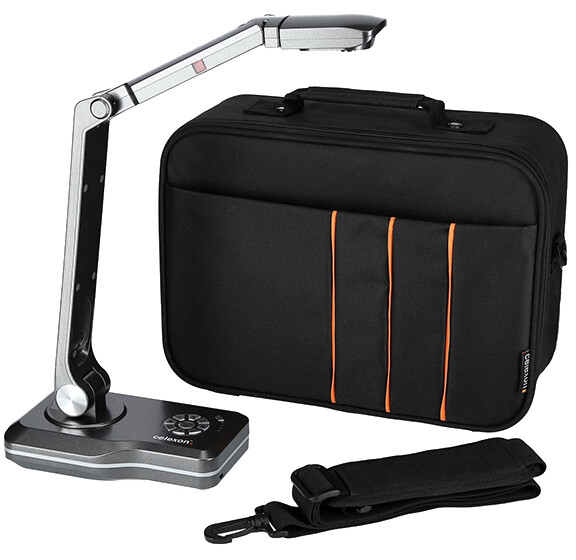



















































£264.99*
- Resolution 1920 x 1080 Full HD
- Camera resolution 8 MP
- Focus type Manual & automatic focus


Product information
A perfect combination: The set consisting of our successfulcelexon document camera DK800 and the matching celexon projector bag Medium isconvenient to use and perfectly suited for long-term success
Bring your document presentation to a new level! With thenew and improved celexon document camera DK800 you have the possibility tochoose from a wider menu navigation, generate sharper image reproduction and usethe document camera safely in public areas.
The DK800 document camera is the ideal and modernreplacement for the classic daylight projector and also offers an interactivepresentation option in real time at maximum image size.
Thanks to simple and intuitive menu navigation, the celexonDK800 document camera can be used immediately with minimal installation effort(plug & play). The extended menu items, such as blackening, spotlight andfade out, allow the presenter to select his or her content and play it out tothe audience. The DK800 offers the option of connecting these to a touch screen(separate cabling required) and thus applying the menu items to the documentsimply and easily via touch commands. The integrated Kensington lock providesthe option of locking the camera securely in freely accessible locations suchas schools, conference rooms or public meetings.
The DK800 is not just for school use: Thanks to theextensive menu and function selection, this camera can also be used as a webcamand document scanner - a true all-rounder for everyday office and home officeuse!
Thanks to its compact housing, low weight and retractablecamera arm, the DK800 is ideal for mobile use. In combination with ourtransport bag, you have a compact and mobile solution that prevents componentsfrom being lost or the camera from being damaged, especially when there aremany changing users.
The CMOS sensor used with its 8 megapixel resolutionprovides a clear and detailed image of your documents. In low light conditions,the two separately controllable LED lamps provide brightening and optimaldisplay.
The camera arm can be tilted and rotated and can thereforebe ideally aligned to the document or a 3D object. A digital zoom also allowsup to 10x magnification.
Key Information:
- Resolution up to FullHD 1920*1080p at up to 60Hz
- High-resolution CMOS sensor with 8MP, automatically adjustsimage brightness
- Flexible articulated arm for space-saving transport - can becombined with our transport bag
- Fully automatic focusing and optional, manual one-touchfocusing
- Macro function up to 5cm object distance to the lens
- Large recording area up to DIN A3 format
- Saving of pictures and videos on SD-card™, including yourelaborated comments or drawings / markers
- 2 LED lamps (separately controlled)
- incl. IR remote control
- Connections: Slot SD-card™, HDMI output, VGA input andoutput, USB
- Live commentary function (drawing lines and graphics)
- Integrated microphone for webcam video calls
- Integrated Kensington anti-theft protection
- Extended menu navigation: blackening, spotlight, fade
- Connection and control via touchscreens
The practical commentary function allows you to use aconnected computer mouse or a presenter with mouse function (celexonLaser-Presenter Expert LP250) to comment the live image with lines and geometricshapes. It is also possible to use a graphics tablet to insert handwrittennotes.
With the celexon DK800 document camera you can worksustainably, because images and videos (including comments) can be easilyarchived and played back on an SD-card™. For example, notes, images or videoscan be made available to the audience at a later date during the presentation.
Thanks to the integrated microphone, the document camera canalso be used as a webcam or for video calls. All functions can be convenientlycontrolled with the included infrared remote control.
In the box:
- celexon document camera DK800
- 1 x HDMI cable
- 1 x VGA cable
- 1 x USB-A cable
- 1 x IR remote control
- 1 x 12V power supply unit
- Operating instructions
Technical data
| Name | celexon document camera DK800 with carrying case M |
|---|---|
| Article number | 1000012251 |
| GTIN/EAN | 4260094740862 |
| Manufacturer SKU | 1000012251 |
| Model name | DK800 |
| variant | With bag |
| Brand | celexon |
| Product Type | Visualizer |
| Product Series | celexon document camera |
| Resolution | 1920 x 1080 Full HD |
| Frames per Second | 60 fps |
| Focus type | Manual & automatic focus |
| Digital Zoom | 0 |
| Camera resolution | 8 MP |
| Camera sensor | CMOS |
| Inputs | 1x VGA |
| Outputs | 1x HDMI , 1x VGA |
| Certificates | CE tested , ROHS |
| Product width | 41 cm |
| Product height | 15 cm |
| Product depth | 29 cm |
| Weight | 2.6 kg |
| Colour | Silver |
| Delivery contents | Bag , HDMI Cable , Power cable , Quick user guide , Remote control , USB cable , VGA cable , strap |
| Condition | New |
| Warranty | 24 Month |
| Warranty type | Bringin service Service and support information |
Product safety
| Person responsible for the EU |
|---|
| celexon Europe GmbH |
| Gutenbergstraße 2 |
| 48282 Emsdetten |
| Germany |
| info@celexon.de |



